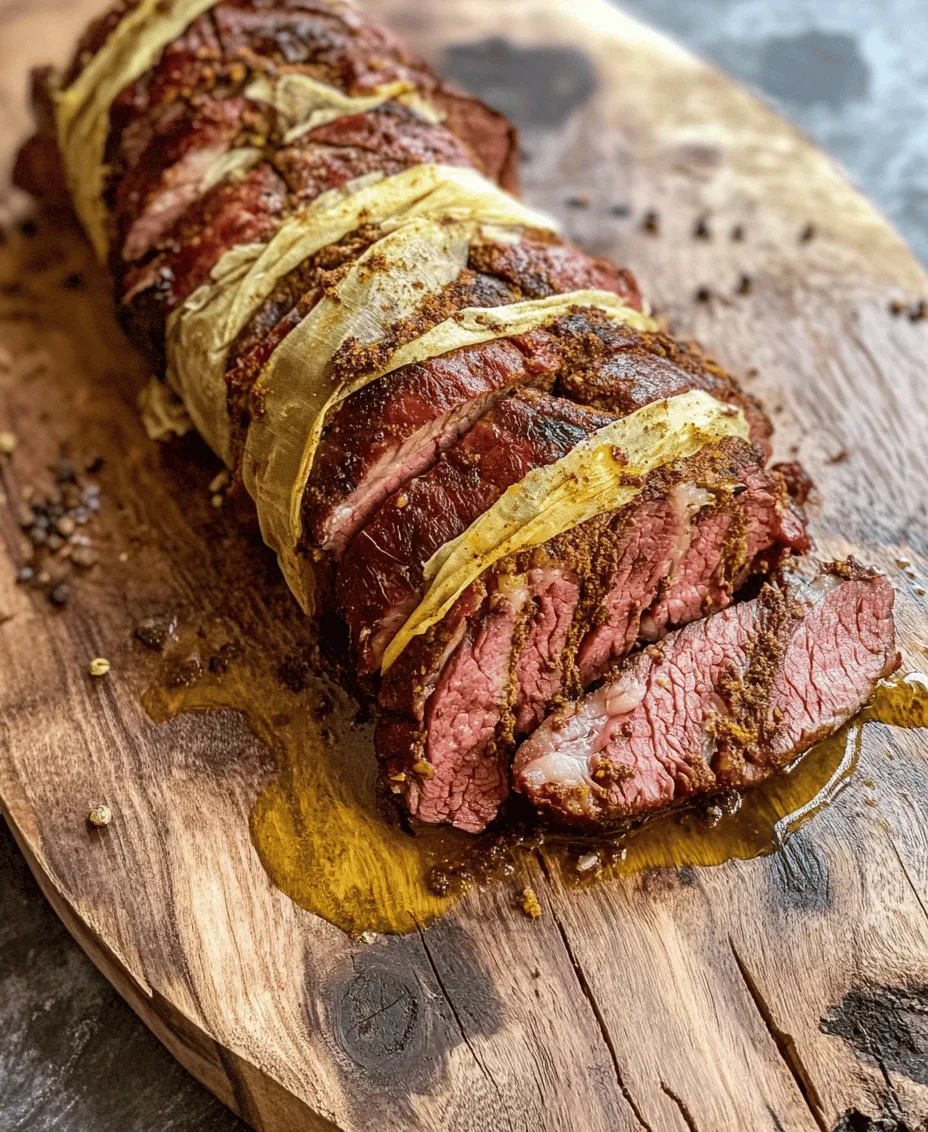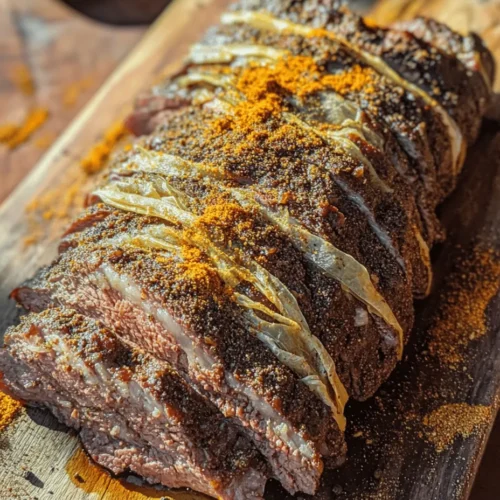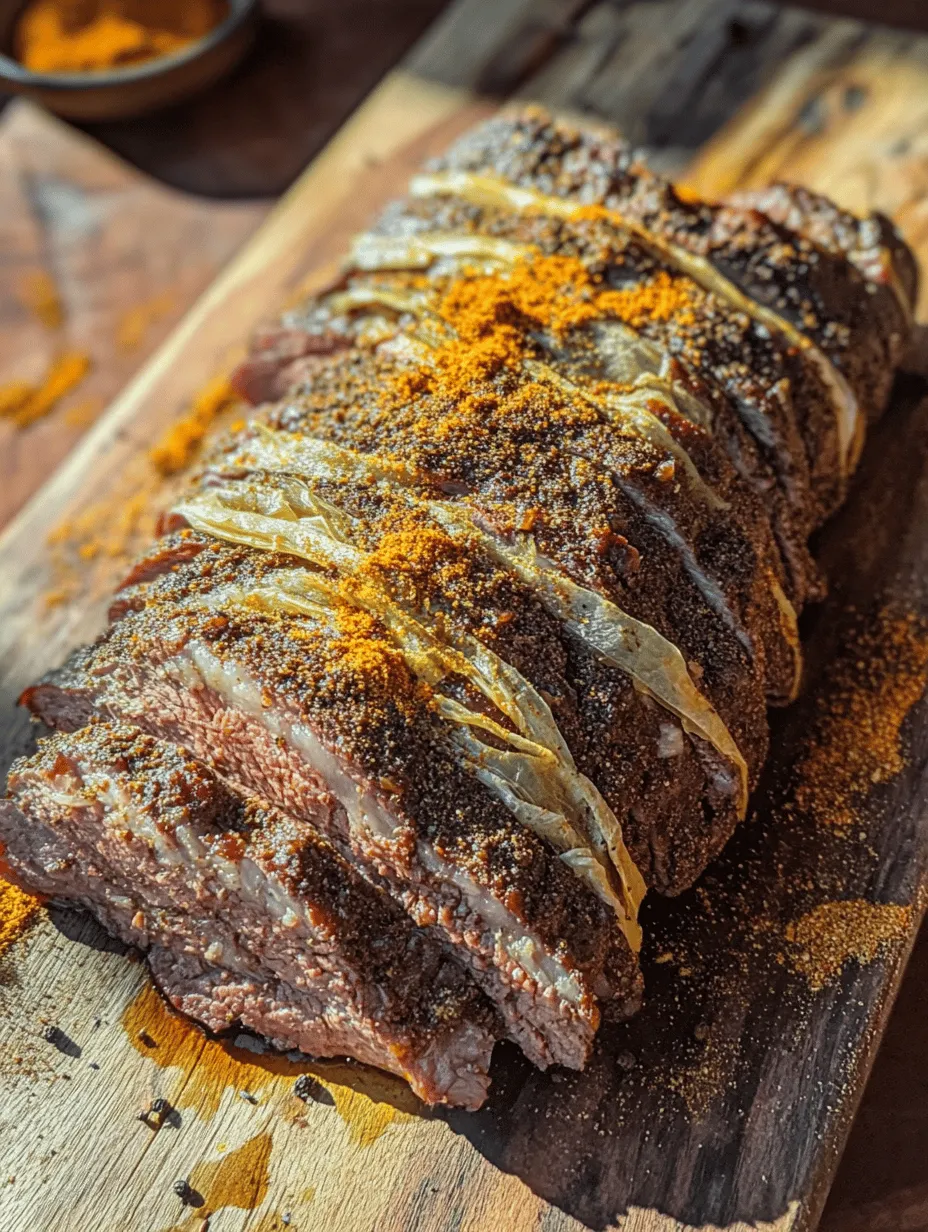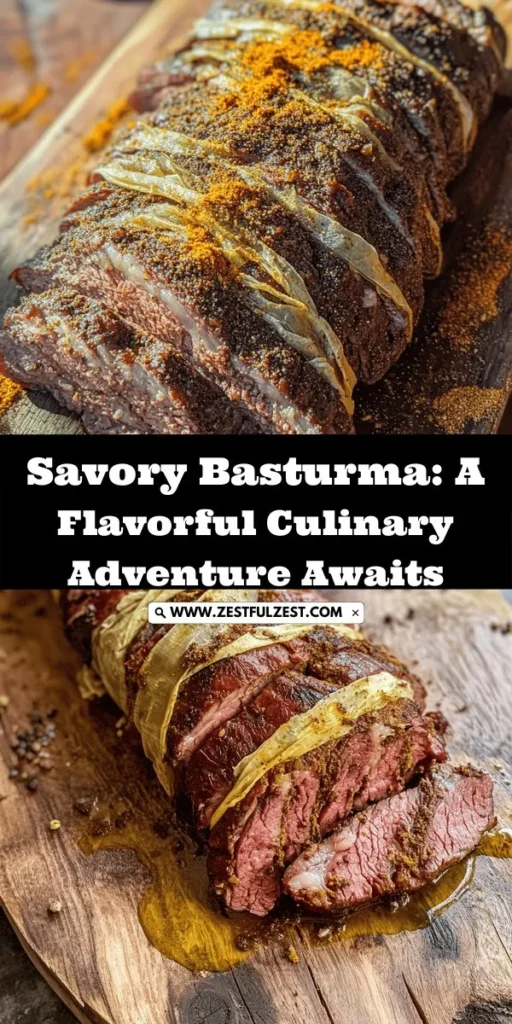Introduction
Basturma, a traditional delicacy that hails from the Mediterranean and Middle Eastern regions, is a testament to the art of preserving and enhancing flavors through time-honored methods. This savory cured meat, often made from beef, has captivated taste buds for centuries with its rich, aromatic profile and unique texture. It’s more than just a dish; it’s a culinary experience steeped in history, culture, and tradition.
In many Mediterranean households, Basturma is not only a staple but also a symbol of hospitality, often served during festive gatherings and special occasions. Its preparation reflects a unique blend of various influences, including those from Turkish, Armenian, and Greek cuisines, showcasing the interconnectedness of food cultures across these regions.
When it comes to the recipe for Savory Basturma Delight, expect a dish that marries the robust flavors of spices with the tender, savory bite of cured beef. The preparation of Basturma requires patience and meticulous attention to detail, as the curing process takes time to develop the deep flavors that make this dish so irresistible.
Understanding Basturma
The origins of Basturma can be traced back to the ancient practices of meat preservation. Traditionally, it was a method utilized by nomadic tribes who relied on curing techniques to make meat last through long journeys and harsh climates. The process involves curing the meat with salt, allowing it to draw out moisture and inhibit the growth of harmful bacteria. This not only preserves the meat but also intensifies its flavor, creating a product that is both safe and delicious.
Curing and drying are at the heart of what makes Basturma special. The beef is typically coated with a blend of salt and spices, a method that has been refined over generations. This approach not only enhances flavor but also imparts nutritional benefits to the meat. When prepared properly, Basturma provides a rich source of protein while being lower in fats compared to many commercially available cured meats, making it a healthier choice for meat lovers.
Ingredients Breakdown
The primary ingredient in any Basturma recipe is the beef itself, commonly sourced from brisket or sirloin. These cuts are favored for their balance of flavor and tenderness, ensuring that the final product is both flavorful and enjoyable to eat.
One of the most crucial components of the curing process is coarse sea salt. This type of salt is preferred due to its larger crystals, which allow for better moisture extraction from the meat, enhancing the curing effect. The amount and quality of salt used can greatly influence the taste and texture of the finished Basturma.
In addition to salt, a variety of spices are integral to creating the signature flavor profile of Basturma. Each spice contributes its unique characteristics:
– Black Peppercorns: These pungent little berries add warmth and depth to the flavor profile of Basturma. Beyond flavor, black pepper has numerous health benefits, including aiding digestion and possessing anti-inflammatory properties.
– Allspice Berries: Known for their aromatic qualities, allspice berries impart a hint of sweetness reminiscent of cinnamon, nutmeg, and cloves. This spice is often used in savory dishes and provides a complex flavor that enhances the overall richness of the Basturma.
– Coriander Seeds: With a light, citrusy flavor, coriander seeds add a refreshing note to the dish. They are also packed with nutrients, including antioxidants and essential oils that promote digestive health.
– Cumin Seeds: Renowned for their earthy and nutty flavor, cumin seeds create a depth that complements the other spices well. Cumin is also known for its various health benefits, including boosting the immune system and aiding digestion.
– Garlic: A beloved ingredient in many cuisines, garlic not only enhances flavor but also boasts numerous health properties. It is known for its ability to boost the immune system and its potential heart-health benefits.
– Fenugreek Leaves: Often overlooked, fenugreek leaves contribute a slightly bitter, nutty flavor that balances the richness of the meat. They are also high in fiber and various vitamins, making them a nutritious addition.
– Paprika: This spice can be sweet or smoked, and the choice between the two can dramatically influence the flavor of the Basturma. Sweet paprika adds a mild sweetness, while smoked paprika infuses a rich, smoky depth.
Finally, olive oil plays a crucial role in the final presentation of the dish. It adds moisture and richness, enhancing the overall flavor while providing healthy fats. This Mediterranean staple is not only delicious but also packed with health benefits, such as anti-inflammatory properties and heart health support.
Preparation Steps
Creating your own Savory Basturma Delight requires careful preparation and adherence to a few essential steps. The first step is to prepare the meat properly. Begin by trimming any excess fat from the beef brisket or sirloin. This is crucial, as too much fat can lead to a greasy final product, which detracts from the authentic Basturma experience.
Once the meat is trimmed, the salting process begins. Generously coat the meat with coarse sea salt, ensuring that every inch is covered. This step is vital, as the salt not only preserves the meat but also infuses it with flavor. The salting process should last for several days, during which the meat will draw out moisture and become firmer. The recommended duration for salting typically ranges from 3 to 5 days, depending on the thickness of the meat and the climate.
After the curing period, the meat will have developed a firmer texture and a deeper flavor. At this stage, it’s important to rinse the salt off thoroughly to prevent an overly salty final product. Once rinsed, pat the meat dry with a clean towel to remove any excess moisture. This step ensures that the spices will adhere properly during the next phase of the preparation.
The next step involves the application of the spice mixture, which is where the magic truly begins. Prepare a blend of crushed black peppercorns, ground allspice, crushed coriander seeds, ground cumin, minced garlic, crushed fenugreek leaves, and paprika. This aromatic combination will envelop the meat and create the signature flavor profile of Basturma. Generously rub this spice mix over the surface of the meat, ensuring that every part is coated evenly.
Once the meat is thoroughly seasoned, it’s time to allow it to dry. Traditionally, this is done by hanging the meat in a cool, dry place with good airflow, allowing the spices to penetrate and the flavors to meld. This drying process can take anywhere from a few days to several weeks, depending on the desired texture and flavor intensity.
With these initial steps, you are well on your way to creating your own Savory Basturma Delight. The journey of crafting this traditional delicacy is not only about the final product; it’s also about embracing the process, learning about the ingredients, and appreciating the rich history behind Basturma. Whether enjoyed as part of a charcuterie board, served with bread, or incorporated into other dishes, homemade Basturma promises to bring a taste of tradition right to your table.

Creating the Spice Mix
The spice mix is the heart of Savory Basturma Delight, and creating the perfect blend is essential for achieving a rich flavor profile. The traditional spice mix typically includes crushed garlic, fenugreek seeds, black pepper, and paprika, which combine to create a unique and aromatic seasoning.
Techniques for Grinding Spices Effectively
To achieve the best flavor, it’s crucial to grind your spices fresh. Using a spice grinder or a mortar and pestle, you can ensure that the spices release their essential oils and flavors. Start by toasting the whole spices lightly in a dry skillet over medium heat until they become fragrant. This process enhances their flavor and aroma. Once cooled, grind them until they reach a fine consistency.
Importance of a Uniform Spice Mix for Flavor Distribution
Uniformity in your spice mix is vital for ensuring that every bite of your basturma is packed with flavor. An uneven mix can lead to some areas being overly seasoned while others are bland. Make sure to sift your ground spices to remove any larger particles, ensuring an even consistency throughout.
Seasoning the Meat
Once your spice mix is ready, it’s time to season the meat. Generously coat the meat with the spice mixture, ensuring every surface is covered. This is where the magic happens—the meat begins to absorb the flavors, setting the stage for the curing process.
Tips for Ensuring Even Coating of the Spice Mixture
To achieve an even coating, use your hands or a spatula to rub the spice mix into the meat. Be thorough, making sure to get into any nooks and crannies. For best results, you can let the seasoned meat sit for a few hours at room temperature, allowing the spices to penetrate the surface before moving on to the curing phase.
The Impact of Flavor Infusion During the Curing Phase
During the curing phase, the flavors will intensify as the meat absorbs the spices. This is a crucial step in developing the rich, savory taste that basturma is known for. The longer you allow the meat to sit with the spice mix, the deeper the flavors will infuse. Typically, a curing period of 48 hours is recommended, but you can experiment based on your taste preferences.
Curing Process
The curing process is essential for transforming your seasoned meat into basturma. This step not only enhances the flavor but also preserves the meat.
Importance of Wrapping the Meat in Cheesecloth
After the curing phase, wrapping the meat in cheesecloth is crucial. This step helps to control moisture loss while allowing air circulation, which is vital for the drying process. Cheesecloth acts as a barrier against contaminants while still permitting the meat to breathe.
How Wrapping Affects Moisture Loss and Flavor Concentration
Wrapping the meat in cheesecloth helps retain moisture but allows enough evaporation to concentrate the flavors. As the basturma dries, the spices will penetrate deeper into the meat, leading to a more intense flavor profile. Ensure that the cheesecloth is tightly secured but not overly restrictive to allow airflow.
Ideal Environmental Conditions for Curing
The ideal environment for curing basturma is cool and dry, with good airflow. A temperature range of 50°F to 60°F (10°C to 15°C) is optimal. Avoid areas with high humidity, as this can lead to spoilage. A dedicated curing chamber or a well-ventilated room can work wonders for your basturma.
Discussion on Temperature and Airflow
Maintaining the right temperature and airflow is essential during the curing process. Too much heat can cook the meat, while inadequate airflow can lead to unwanted bacteria growth. If possible, use a fan to circulate air in the curing area, ensuring that the meat dries evenly and thoroughly.
Tips for Monitoring the Curing Process
Check the basturma regularly during the curing process. Look for changes in texture and smell. The meat should become firmer and develop a rich aroma. If you notice any off-putting odors or excessive moisture, adjust the airflow or temperature as needed.
Final Preparation and Serving Suggestions
Determining when your basturma is ready requires a bit of intuition.
How to Determine When the Basturma Is Ready
The basturma is ready when it has a firm texture and a dry exterior. It should not be sticky or moist to the touch. A good test is to press on the surface; if it feels firm and springs back, it’s time to slice.
Techniques for Slicing and Serving
Use a sharp knife to slice the basturma thinly. Thin slices allow the flavors to shine and make for easier incorporation into various dishes. Serve the basturma as part of a charcuterie board, alongside crusty bread, olives, and cheeses, or use it as a flavorful addition to sandwiches.
Creative Ways to Incorporate Basturma in Meals
Basturma can elevate many dishes. Try adding it to salads for a protein boost, or toss it into pasta dishes for a savory twist. You can also sauté it with vegetables for a delicious stir-fry or use it as a topping on pizza for an extra kick.
Pairing Suggestions with Wines or Other Dishes
When it comes to pairing, a robust red wine complements the rich flavors of basturma beautifully. Consider serving it with a full-bodied Cabernet Sauvignon or a spicy Syrah. Alternatively, pair it with Mediterranean dishes, such as hummus or tabbouleh, to create a well-rounded meal.
Storage and Longevity
Proper storage is crucial for maintaining the quality of your homemade basturma.
Best Practices for Storing Basturma
Store your basturma in an airtight container or vacuum-sealed bag to keep it fresh. If properly stored, it can last for several weeks in the refrigerator.
Refrigeration Versus Freezing for Long-Term Storage
For long-term storage, freezing is the best option. Wrap the basturma tightly in plastic wrap or aluminum foil before placing it in a freezer-safe bag. This method helps prevent freezer burn and preserves its flavor and texture.
Understanding the Shelf Life of Homemade Basturma
Homemade basturma can retain its quality for up to six months in the freezer. In the refrigerator, it typically lasts about two to three weeks. Always check for any signs of spoilage, such as off odors or changes in texture, before consuming.
Tips on Maintaining Quality During Storage
To maintain the best quality, avoid exposing your basturma to air, which can lead to oxidation and flavor loss. Use a dedicated container that minimizes exposure and check periodically for freshness.
Conclusion
In summary, making Savory Basturma Delight is a rewarding culinary journey that brings together the art of seasoning, curing, and flavor infusion. From creating the perfect spice mix to mastering the curing process, each step contributes to this delicious delicacy. Embrace the art of curing meat at home and impress your family and friends with your culinary skills. Enjoy sharing this flavorful treat, whether in sandwiches, salads, or as part of a charcuterie board, and savor the satisfaction of having crafted something truly special.



